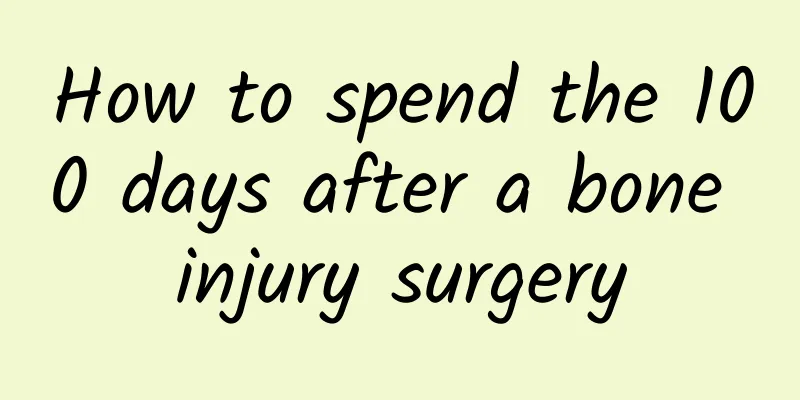How to spend the 100 days after a bone injury surgery

|
Orthopedic surgery is either "injuring the tendons" - repairing tendons and ligaments, or "moving bones" - resetting and fixing fractures. As the saying goes, "It takes a hundred days to heal a broken bone after a broken tendon", which means that after a broken bone, the human body needs 100 days to recover. This saying makes sense, because it takes 8 to 12 weeks to repair tendons and ligaments and heal fractures. For elderly patients, the healing time will be delayed, and functional recovery will take more time, which does take almost 100 days in total. However, many people have a deep misunderstanding of this sentence, that is, they think that they need to rest well and not move during these 100 days, and they will be back to normal after 100 days. This idea is completely wrong. So how should we "recover" after orthopedic surgery, and how can we spend these "100 days" to recover as before? After the correct surgical treatment by the orthopedic surgeon, the patient should first pay attention to his or her postoperative pain. Generally, there will be obvious pain within 3 to 5 days after the operation. Actively using local surgical area or intravenous infusion analgesia pumps and different levels of analgesics to get through the pain period is very beneficial for postoperative recovery. These short-term use of analgesics will not have too many adverse reactions, so patients do not have to worry too much. Secondly, you need to fully communicate with the surgeon to clarify which postoperative activities are strictly contraindicated. For example, some lower limbs need to be free of weight bearing (the feet cannot touch the ground) after surgery, so you need to confirm the degree and time limit of free weight bearing with the surgeon. Some joints need to limit the range of motion after surgery, so you need to communicate with the surgeon to confirm the specific angle of restricted activity. Within this angle range, can active activities be performed, or can neither active nor passive activities be performed. In addition, it is necessary to clarify how long this restriction will last. If there are metal implants (nails, steel plates, joint prostheses, etc.), ask the doctor whether these metal implants will affect MRI examinations to determine whether MRI examinations and electromagnetic-related treatments can be performed in the future. Thirdly, try to stay active while complying with the surgeon's contraindications. This conflicts with the understanding of some people that a broken bone needs to be recuperated for 100 days. Some patients or their families think that "resting" means staying in bed, not letting the patient move, and giving the patient various nutritional supplements to "replenish" the body. This kind of "resting" is totally wrong. Not to mention that such rest can lead to muscle atrophy, joint adhesion, decreased cardiopulmonary function, etc., which is not conducive to the recovery of systemic function after surgery, and may even bring serious complications, such as aspiration pneumonia, venous thrombosis, and sudden death from pulmonary embolism. So, how do you “stay as active as possible”? First, get out of bed. Except for some special surgeries that require bed rest, most orthopedic surgeries require patients to get up as soon as possible, stay upright (including sitting and standing) during non-sleeping hours, and reduce bed rest time. This can significantly reduce the occurrence of complications such as pneumonia and decreased cardiopulmonary function, and getting out of bed is beneficial to improving the patient's mood. Second, keep non-surgical areas as mobile as possible. If the surgery is done on an upper limb and the patient is able to walk normally, then maintaining a certain amount of walking activity is not only good for maintaining cardiopulmonary function, but also improves blood circulation throughout the body during walking, which also promotes the recovery of the surgical site. After surgery on a single upper limb, if the affected side is immobilized to varying degrees, we can also indirectly improve the function of the affected side through training of the contralateral upper limb. If the surgery is done on the lower limbs, and there are no restrictions on the affected limb to avoid weight bearing, the patient should walk as soon as possible. If there are restrictions on the affected limb to avoid weight bearing, the patient should choose appropriate assistive devices according to the patient's specific situation and use them correctly to achieve walking with the assistance of the device as soon as possible. It is recommended to consult a professional rehabilitation doctor for the selection and use of specific assistive devices. Third, for functional rehabilitation of the surgical site, you should consult a professional rehabilitation doctor. Based on the patient's age, previous exercise habits, mobility, surgical contraindications, etc., an individualized rehabilitation plan is developed for the patient, allowing the patient to perform rehabilitation exercises step by step, and ultimately truly recover as before. To sum up, after orthopedic surgery, you should try to maintain scientific activities and go to the rehabilitation department as soon as possible after the operation. Generally speaking, orthopedic surgeons will work with rehabilitation doctors to jointly manage patients. If the patient does not receive guidance from a rehabilitation doctor after surgery, it is recommended that you take the initiative to bring the surgical records and the orthopedic surgeon's postoperative contraindications and come to the rehabilitation department as soon as possible. This will allow recovery after "injuries" to be smoother. In addition, patients and their families are generally very concerned about nutrition. During these 100 days, because the overall amount of exercise has decreased compared to before, it is necessary to control the total calories of food intake to avoid weight gain. It is enough to ensure sufficient daily intake of fiber, protein and calcium. After a successful orthopedic surgery, scientific and early rehabilitation training is the best option after "injuries". |
<<: How to prevent blue light damage when looking at the screen for a long time
Recommend
Why is there bleeding two days after sex?
When a couple has sex, they must have methods and...
Can I jump rope during menstruation?
During menstruation, you should pay special atten...
When is the best time for women to get an IUD?
Technology is developing very rapidly now, and th...
What to do if you are irritable during menstruation
In fact, as women all know, every time you have y...
What Chinese medicine can women drink to replenish qi and nourish blood
For women, if the qi and blood are insufficient, ...
What are the dangers of getting angry before menstruation?
It is very harmful to women's health if they ...
What is the nutritional value of scrambled eggs with green peppers? How to scramble scrambled eggs with green peppers? Do you put the eggs in first?
Eggs, except for the low content of vitamin C, co...
Why does the secretion increase and turn yellow? Gynecologists explain the reasons!
The so-called increased secretion actually refers...
There is a lump next to my breast. What is the reason behind it?
Due to various complex reasons, flesh lumps will ...
Introduction to diet after caesarean section
In life, many friends have to undergo cesarean se...
Pain below during menstruation
Nearly half of women in the world suffer from men...
What causes large blood clots during menstruation?
When you have your period, the most direct sympto...
How to avoid getting sick during the postpartum period?
After a miscarriage, a woman's body is severe...
Why do women always have the urge to urinate?
Most women in our country often suffer from gynec...
What are the symptoms of pregnancy at the beginning?
What are the symptoms of being pregnant for one o...









